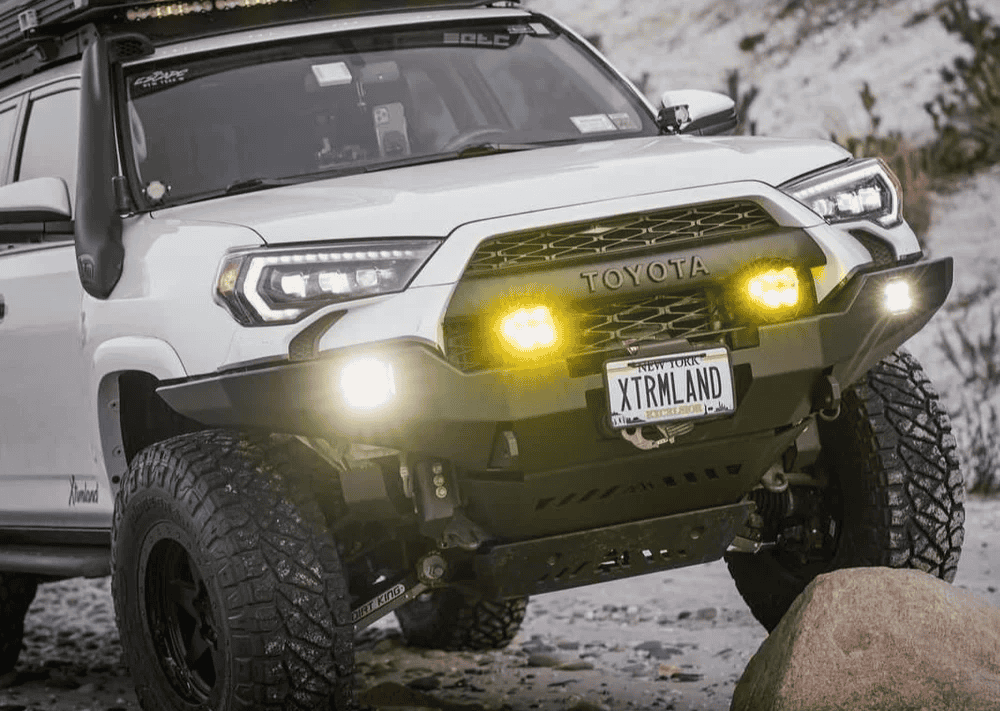Overland Vehicles

Winch mount fabrication is about controlling force. The drum creates tremendous line pull that must flow into the frame rails without twisting crossmembers or tearing thin crash structures. A sound design anchors into high strength zones on both rails, spreads load with thick plates, and keeps the winch centered so the rope pays evenly across the drum. The standard winch footprint of ten by four point five inches dictates hole placement, but the surrounding structure carries the real work. Plan for rated line pull plus a safety factor to handle snatch loads and angled recoveries.
Engineering checkpoints before you cut steel:
A smart mount integrates recovery points near the frame joints. Closed loop tabs in double shear keep shackles aligned and reduce bending on bolts during complex recoveries. Tie the fairlead window to the main plate so the opening cannot deform and pinch synthetic rope. Finally, position the winch low but not so low that water crossings flood the motor or clutch.
Material selection drives strength and weight. Many fabricators use mild steel plate for main structure due to predictable welding and toughness. Quarter inch plate is common for the primary feet and frame plates, with three sixteenth skins and braces. Where bolts clamp into the frame, thicker plates such as three eighths inch resist ovaling. High strength low alloy options can cut weight if you understand weld procedures and heat input. Add radiused corners to reduce stress risers and include drain paths so mud and salt do not pack and corrode hidden seams.
Fairlead choice affects rope life and packaging. A hawse fairlead is compact and pairs well with synthetic line, while a roller fairlead can be forgiving with steel cable but takes more space and can snag. Provide straight rope lead from the fairlead to the drum centerline to avoid side loading the mount. Ensure the clutch lever is reachable with gloves, and that the motor terminals are protected yet serviceable. Consider a remote control passthrough or a contactor location shielded from water spray.
Cooling and airflow are easy to overlook. The winch can block airflow to the radiator and intercooler, especially on small grill openings. Add louvers or ducting so the fan can pull air at idle during long recoveries. Plan for license plate relocation, camera views, and fog light placement. Many modern vehicles use radar and parking sensors within the bumper cover. A proper mount provides clear sight lines or relocates sensors without reflections that cause false alerts.
Weld quality decides whether the numbers on paper show up on the trail. Gas metal arc welding with the correct wire and gas mix offers repeatable penetration on thicker plate. Pulse settings help when joining thin skins to heavier structure. Gas tungsten arc welding can be useful for tight joints and control near sensitive components. When the design is bolt on, select Grade 8 or metric 10.9 hardware with large washers or backing plates. Use proper torque values and threadlocker, and retorque after the first recovery to account for seating.
Late model frames include crush zones and thin stamped sections that are not intended for recovery loads. A well designed mount lands on boxed sections or factory tow points and uses interlocking tabs to keep geometry stable. Keep weight centered and as close to the axle as packaging allows, since added mass forward of the axle can affect steering feel and braking. Check the suspension and consider higher rate springs if the bumper and winch add significant static load.
Validation is as important as design. Start with a mockup that confirms clearances for sway bars, intercoolers, and sensor modules. Use a test stand or controlled pull to verify that the rope pays evenly under tension. Watch for deflection at the fairlead opening and any movement at the frame plates. After a few heat cycles and a day in the rain, check for corrosion traps and water ingress into electrical connectors.
A credible test series includes static pull checks near rated load, off axis angles to simulate real recoveries, and repeat cycles to reveal fatigue. Inspect weld toes for cracks and measure bolt stretch or loss of torque. Field feedback matters too. Note how fast you can access the clutch, whether gloves snag on edges, and how easy it is to wash mud out of corners. A winch mount that performs well in testing saves time and risk when conditions get rough.
As you think through your own setup, study how a complete vehicle package comes together. Strong mounts, tuned suspension, and balanced armor create confidence on remote routes. If you want a build designed as a system, take a look at explore overland rigs and see how structure, power, and storage can live together without compromise. When it is time for a tailored solution that integrates sensors, lighting, and service access, our team handles end to end planning through custom overland upfit. Curious about how we work and what to expect during a build journey, including handoff at our lounge and test drive routes in Northwest Arkansas, learn more at why choose OZK Customs.
If your rig needs a purpose built winch mount, a full steel bumper, or a complete adventure package, we design and fabricate solutions that match how you travel. From frame tied mounts and closed loop recovery points to sensor friendly packaging and corrosion protection, we build for the real world. Tell us about your platform, terrain, and gear, and we will deliver a tested system you can trust when the pull gets serious.
Ready for a purpose built winch mount or integrated bumper that fits your rig and your terrain. Tell us how you travel and we will design, fabricate, and install a tested solution in Fayetteville. Secure your build slot now and let OZK Customs turn your plan into steel.
ADDRESS:
6159 E Huntsville Rd, Fayetteville, AR 72701
PHONE:
(479) 326-9200
EMAIL:
info@ozkvans.com